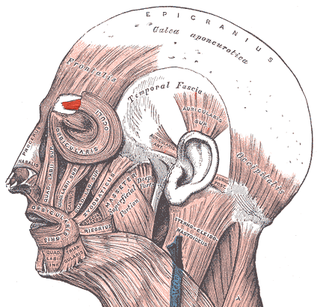Emotions are biological states associated with the nervous system brought on by neurophysiological changes variously associated with thoughts, feelings, behavioural responses, and a degree of pleasure or displeasure. There is currently no scientific consensus on a definition. Emotions are often intertwined with mood, temperament, personality, disposition, creativity and motivation.
Psychophysiology is the branch of psychology that is concerned with the physiological bases of psychological processes. While psychophysiology was a general broad field of research in the 1960s and 1970s, it has now become quite specialized, and has branched into subspecializations such as social psychophysiology, cardiovascular psychophysiology, cognitive psychophysiology, and cognitive neuroscience.
Affective computing is the study and development of systems and devices that can recognize, interpret, process, and simulate human affects. It is an interdisciplinary field spanning computer science, psychology, and cognitive science. While some core ideas in the field may be traced as far back as to early philosophical inquiries into emotion, the more modern branch of computer science originated with Rosalind Picard's 1995 paper on affective computing and her book Affective Computing published by MIT Press. One of the motivations for the research is the ability to give machines emotional intelligence, including to simulate empathy. The machine should interpret the emotional state of humans and adapt its behavior to them, giving an appropriate response to those emotions.

Paul Ekman is an American psychologist and professor emeritus at the University of California, San Francisco who is a pioneer in the study of emotions and their relation to facial expressions. He was ranked 59th out of the 100 most cited psychologists of the twentieth century. Ekman conducted seminal research on the specific biological correlations of specific emotions, attempting to demonstrate the universality and discreteness of emotions in a Darwinian approach.

Electromyography (EMG) is an electrodiagnostic medicine technique for evaluating and recording the electrical activity produced by skeletal muscles. EMG is performed using an instrument called an electromyograph to produce a record called an electromyogram. An electromyograph detects the electric potential generated by muscle cells when these cells are electrically or neurologically activated. The signals can be analyzed to detect medical abnormalities, activation level, or recruitment order, or to analyze the biomechanics of human or animal movement. In Computer Science, EMG is also used as middleware in gesture recognition towards allowing the input of physical action to a computer as a form of Human-computer interaction.

Advertising management is a planned managerial process designed to oversee and control the various advertising activities involved in a program to communicate with a firm's target market and which is ultimately designed to influence the consumer's purchase decisions. Advertising is just one element in a company's promotional mix and as such, must be integrated with the overall marketing communications program. Advertising is, however, the most expensive of all the promotional elements and therefore must be managed with care and accountability. Advertising management process also helps in defining the outline of the media campaign and in deciding which type of advertising would be used before the launch of a product.
Affective neuroscience is the study of the neural mechanisms of emotion. This interdisciplinary field combines neuroscience with the psychological study of personality, emotion, and mood. The putative existence of 'basic emotions' and their defining attributes represents a long lasting and yet unsettled issue in psychology.
Neuromarketing is a commercial marketing communication field that applies neuropsychology to marketing research, studying consumers' sensorimotor, cognitive, and affective response to marketing stimuli. Neuromarketing seeks to understand the rationale behind how consumers make purchasing decisions and their responses to marketing stimuli in order to apply those learnings in the marketing realm. The potential benefits to marketers include more efficient and effective marketing campaigns and strategies, fewer product and campaign failures, and ultimately the manipulation of the real needs and wants of people to suit the needs and wants of marketing interests.
Central facial palsy is a symptom or finding characterized by paralysis or paresis of the lower half of one side of the face. It usually results from damage to upper motor neurons of the facial nerve.
Advertising research is a systematic process of marketing research conducted to improve the efficiency of advertising. Advertising research is a detailed study conducted to know how customers respond to a particular ad or advertising campaign.
Copy testing is a specialized field of marketing research that determines an advertisement's effectiveness based on consumer responses, feedback, and behavior. Also known as pre-testing, it might address all media channels including television, print, radio, outdoor signage, internet, and social media.
Affect displays are the verbal and non-verbal displays of affect (emotion). These displays can be through facial expressions, gestures and body language, volume and tone of voice, laughing, crying, etc. Affect displays can be altered or faked so one may appear one way, when they feel another. Affect can be conscious or non-conscious and can be discreet or obvious. The display of positive emotions, such as smiling, laughing, etc., is termed "positive affect", while the displays of more negative emotions, such as crying and tense gestures, is respectively termed "negative affect".
Emotional self-regulation or emotion regulation is the ability to respond to the ongoing demands of experience with the range of emotions in a manner that is socially tolerable and sufficiently flexible to permit spontaneous reactions as well as the ability to delay spontaneous reactions as needed. It can also be defined as extrinsic and intrinsic processes responsible for monitoring, evaluating, and modifying emotional reactions. Emotional self-regulation belongs to the broader set of emotion regulation processes, which includes both the regulation of one's own feelings and the regulation of other people's feelings.
Emotional responsivity is the ability to acknowledge an affective stimuli by exhibiting emotion. Increased emotional responsivity refers to demonstrating more response to a stimulus. Reduced emotional responsivity refers to demonstrating less response to a stimulus. Any response exhibited after exposure to the stimulus, whether it is appropriate or not, would be considered as an emotional response. Although emotional responsivity applies to nonclinical populations, it is more typically associated with individuals with schizophrenia and autism.
Claude E. Robinson (1900–1961) was an American pioneer in advertising research and opinion survey research techniques. Along with George Gallup, he was instrumental in developing many scientific sampling techniques that were later used in Gallup polls and other public opinion research surveys.

Facial electromyography (fEMG) refers to an electromyography (EMG) technique that measures muscle activity by detecting and amplifying the tiny electrical impulses that are generated by muscle fibers when they contract.

The study of 'music and emotion' seeks to understand the psychological relationship between human affect and music. It is a branch of music psychology with numerous areas of study, including the nature of emotional reactions to music, how characteristics of the listener may determine which emotions are felt, and which components of a musical composition or performance may elicit certain reactions. The field draws upon, and has significant implications for, such areas as philosophy, musicology, music therapy, music theory and aesthetics, as well as the acts of musical composition and performance.
Emotion perception refers to the capacities and abilities of recognizing and identifying emotions in others, in addition to biological and physiological processes involved. Emotions are typically viewed as having three components: subjective experience, physical changes, and cognitive appraisal; emotion perception is the ability to make accurate decisions about another's subjective experience by interpreting their physical changes through sensory systems responsible for converting these observed changes into mental representations. The ability to perceive emotion is believed to be both innate and subject to environmental influence and is also a critical component in social interactions. How emotion is experienced and interpreted depends on how it is perceived. Likewise, how emotion is perceived is dependent on past experiences and interpretations. Emotion can be accurately perceived in humans. Emotions can be perceived visually, audibly, through smell and also through bodily sensations and this process is believed to be different from the perception of non-emotional material.
Facial coding is the process of measuring human emotions through facial expressions. Emotions can be detected by computer algorithms for automatic emotion recognition that record facial expressions via webcam. This can be applied to better understanding of people’s reactions to visual stimuli.
Automated Pain Recognition (APR) is a method for objectively measuring pain and at the same time represents an interdisciplinary research area that comprises elements of medicine, psychology, psychobiology, and computer science. The focus is on computer-aided objective recognition of pain, implemented on the basis of machine learning.




